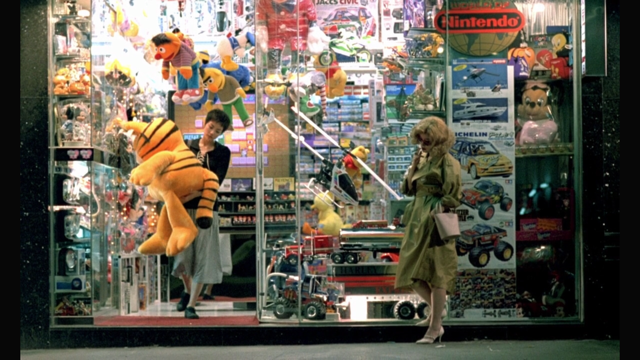Revisiting Wong Kar-wai’s Fallen Angels
Review of Fallen Angels
Written by Teen Writer Owen Chilcote and edited by Teen Editor Eleanor Cenname

Few filmmakers are able to highlight the longings of modern people as stylishly as Wong Kar-wai.
The Chinese-born director has made a name for himself with an exceptionally consistent filmography. Ranging from the hyperactive and kaleidoscopic Chungking Express to the internationally renowned In the Mood For Love, each of his films manages to accomplish the astonishing balancing act of being both stylistically unique and emotionally resonant. However, of all of his exceptional work (most of which are playing in a glorious new 4K restoration at SIFF), no film is a sharper distillation of his signature hyper-kinetic melancholy than his 1995 masterpiece, Fallen Angels.
Fallen Angels was originally conceived as the third part of 1994’s Chungking Express—a movie divided into two distinct stories linked together primarily through motifs—and an observant viewer could find the traces of that film in this one. The fragmented structure, based upon two different relationships, is certainly familiar, and symbols of blond hair and cans of expired pineapple (which feature prominently in Chungking Express) reappear and gain new meaning in Fallen Angels. But the movie really works much better as a darker foil to Chungking Express than as a direct sequel.

Take, for example, the brooding contract killer and his “partner,” whose character dynamic—along with some John Woo-style shootout sequences—make up the first half of the movie. While the primary conflict in Chungking Express was the characters’ inability to express their feelings to each other, in Fallen Angels it is their unwillingness to allow themselves to be emotionally connected to another person. The film lets us know this fact almost immediately during the opening monologue: “We’ve been business partners for 155 weeks now. We’re sitting next to each other for the first time today. We seldom see each other because it is hard to control one's emotions. Partners should never get emotionally involved.”
Interior monologues like the one quoted above appear regularly throughout the film. Along with well-placed pop song selections, they take up the majority of the soundtrack, replacing conventional dialogue. And for good reason, as they act as the glue that holds this film together, connecting each of the deeply atmospheric vignettes into a whole.
There’s really very little tangible narrative structure to Fallen Angels. Even as someone who’s seen the movie multiple times, it’s hard to pin down a concrete plot. Each scene gives way to the next at such a quick pace that all that’s left are images and snatches of dialogue. It’s hard to make a great argument for the overall value of these structural choices (or lack of such), but this high a density of memorable moments is incredibly hard to find in any other film.
Fallen Angels is ultimately defined by its late-night neon-soaked atmosphere, not its story. Much of the credit for this atmosphere is owed to Wong’s go-to cinematographer, Christopher Doyle, who assembles a stunning collage of seductive pop-art imagery. Shot primarily at night using only extreme wide-angle lenses, the film's visuals are kinetic and propulsive, each shot more exciting than the last.
The movie is a barrage of seductive images: a motorcycle ride, a woman's face reflecting onto a jukebox, a ride in an ice cream truck, a digital video ode to a father, the best shot of someone eating noodles I have ever seen on film. Each image gives way to the next in a rapid-fire montage of gleeful improvisation. Every moment, however mundane, manages to be funny or moving or cool or even all of those at once.
This is why Fallen Angels works so well. Even though the movie is loose, goofy, and sometimes more ambitious than it needs to be, Wong’s ultra-romantic sensibilities and clever writing add a surprising amount of emotional depth and technical savvy to an exhilarating romance movie destined to be a future cult classic.
Lead Photo Credit: Wong Kar-wai's Fallen Angels (1995).
The TeenTix Newsroom is a group of teen writers led by the Teen Editorial Staff. For each review, Newsroom writers work individually with a teen editor to polish their writing for publication. The Teen Editorial Staff is made up of 6 teens who curate the review portion of the TeenTix blog. More information about the Teen Editorial Staff can be found HERE.
The TeenTix Press Corps promotes critical thinking, communication, and information literacy through criticism and journalism practice for teens. For more information about the Press Corps program see HERE.

